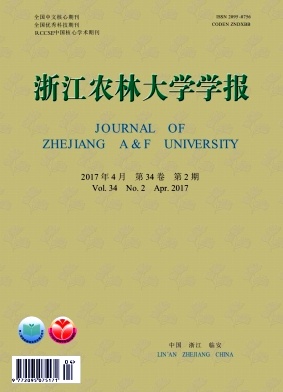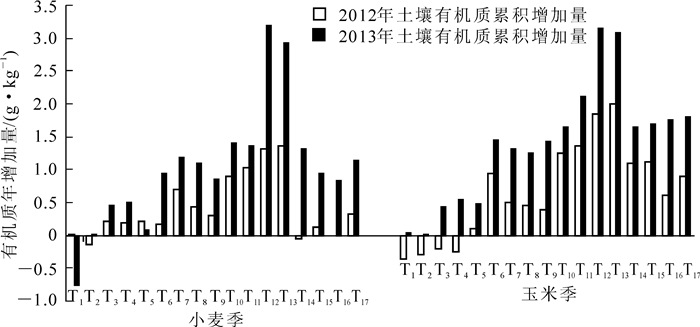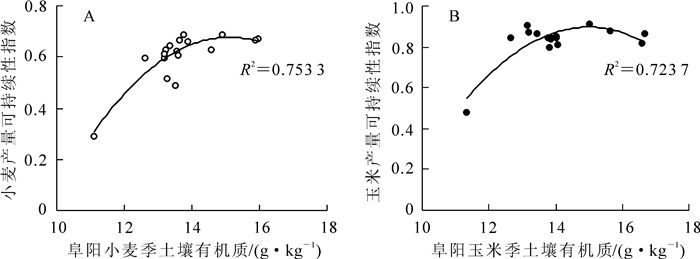-
土壤是人类赖以生存的物质基础[1]。土壤肥力是土壤质量的核心,是众多土壤肥力要素综合作用的反映[2]。土壤有机质是土壤养分的重要来源,是决定土壤质量的基本指标之一,也是土地生产力的重要指标[3-7]。长期肥力肥效定位试验被认为是研究肥料对作物产量、土壤肥力和环境等影响的可靠方法,可以为研究不同培肥措施对生态环境、土壤肥力及作物产量的影响提供可靠的数据,是短期试验所不可比拟的[8-9]。施肥是土壤肥力演变最直接的影响因子[10-13],但是如果土壤有机质大量流失,即使大量施肥,土壤的持续生产力也会降低[14]。有机肥富含植物生长所需的各种必需元素及有机养分,能够满足作物不同生长期对各种养分的需求,可以改善土壤结构和理化性质。因此,增施有机肥,以有机肥替代部分化肥,减少化肥用量是解决这些问题的有效途径。为此前人进行了许多研究,来揭示土壤培肥后土壤有机质含量的变化规律以及作物产量与土壤有机质含量的关系[15]。本研究以安徽省阜阳市砂姜黑土肥力肥效长期定位试验基地为平台,探讨长期有机无机肥料配施对土壤有机质含量及作物产量的提升作用,为寻求培育作物稳产高产的土壤结构和环境,提高土壤耕地质量的途径提供科学依据。
HTML
-
本研究选取砂姜黑土长期肥力肥效定位试验基地,试验点为安徽科技学院安徽阜阳临泉农科所(32°55′N,E 115°06′E)。试验为华北平原占主导的冬小麦Triticum aestivum和夏玉米Zea mays 1 a 2熟栽植模式,施肥浇水均按照华北平原传统管理模式。
-
试验根据“不同有机肥种类+有机肥不同施用量+秸秆不同利用方式”,可归类为“对照组”“施化肥组”“有机肥+化肥组”“化肥+秸秆组”“有机肥+化肥+秸秆组”和“有机无机复合肥组”,共17个处理。试验点采用完全随机区组设置(重复4次·处理-1),共68个小区。各个小区的大小为10 m × 5 m,各小区间隔1 m,区组间间隔2 m,具体试验处理见表 1。所施化肥为尿素、过磷酸钙和硫酸钾复合肥[m(46%氮肥):m(16%五氧化二磷):m(50%氧化钾)=1.0 : 1.3 : 0.4的比例配制成],有机肥采用猪粪和牛粪,施肥量按当地常规用量计算,有机肥施用量按养分分析后的实际含量折算,所有肥料全部用作基肥。
处理 处理编号 施肥方式 对照 ck T1 不施肥处理 化肥 NPK T2 100%施化肥处理 (当地用量) 有机肥+化肥 P200NPK70 T3 猪粪3 000 kg·hm-2+70%化肥 C200NPK70 T4 猪粪3 000 kg·hm-2+70%化肥 P400NPK50 T5 猪粪6 000 kg·hm-2+50%化肥 C400NPK50 T6 猪粪6 000 kg·hm-2+50%化肥 化肥+秸秆 SNPK T7 秸秆全量还田+100%化肥 SC10NPK T8 秸秆全量还田+100%化肥+150 kg·hm-2秸秆伴侣 SC20NPK T9 秸秆全量还田+100%化肥+300 kg·hm-2秸秆伴侣 有机肥+化肥+秸秆 P200NPK70S T10 猪粪3 000 kg·hm-2+70%化肥+秸秆全量还田 C200NPK70S T11 猪粪3 000 kg·hm-2+70%化肥+秸秆全量还田 P400NPK50S T12 猪粪6 000 kg·hm-2+50%化肥+秸秆全量还田 C400NPK50S T13 猪粪3 000 kg·hm-2+50%化肥+秸秆全量还田 有机无机复合肥 PC120NPK50 T14 猪粪堆肥有机无机复合肥1 800 kg·hm-2 CC120NPK50 T15 牛粪堆肥有机无机复合肥1 800 kg·hm-2 PC240NPK50 T16 猪粪堆肥有机无机复合肥3 600 kg·hm-2 CC240NPK50 T17 牛粪堆肥有机无机复合肥3 600 kg·hm-2 Table 1. Experimental treatments
试验点小麦-玉米种植基本流程:收获作物—粉碎秸秆—划分小区—去除秸秆—撒秸秆伴侣(能加速秸秆降解的微生物菌剂)—犁地—分划小区施肥—旋地—起垄—压地—播种—压地—起垄。试验点在2010-2012年间每年10月播种小麦,翌年6月收获小麦;2011年-2013年间每年6月移栽玉米,当年10月收获玉米。
-
土壤取样方法:在各个处理小区的测定区内沿“S”型或“X”型路线设置采样点;设置采样点4~5个·小区-1,采样点距离样地边界1 m以上,削去表层浮土,采集耕作层(0~20 cm)土壤,将各取样点土样混匀,过2 mm筛,装袋保存;并贴上标签,记录采样人、采样地点、采样时间以及采样地区特征等相关采样信息。每季作物收获时测定作物产量,收获后采集耕层土样,测定其有机质质量分数(重铬酸钾容量法)。
-
试验数据统计分析和作图使用R(2.15.3),SPSS 20.0和Excel 2010软件进行。
1.1. 试验地概况
1.2. 试验设计
1.3. 试验分析方法
1.4. 数据处理
-
为分析不同处理对土壤有机质的影响,尤其是加入有机肥后的影响,本研究把对照处理和氮磷钾处理作为基础对比处理组,通过比较其他15个处理与基础对比组有机质的差异,来确定能提高有机质的最优处理。从表 2可知:较对照处理和氮磷钾处理,其余施肥处理都促进了土壤有机质的积累。其次,在2季作物下,有机质增长效果明显的处理相同,均为T10,T11,T12和T13等4个处理。综上表明:以有机肥代替部分化肥和秸秆还田处理有利于农田土壤有机质积累。单从有机质增长幅度看,减量50%的化肥处理普遍比减量30%的化肥处理好。
处理 小麦季 玉米季 增长率 (对照处理)/% 增长率 (氮磷钾处理)/% 增长率 (对照处理)/% 增长率 (氮磷钾处理)/% T1 T2 13.68 11.55 T3 18.98 4.66 16.00 3.99 T4 19.26 4.91 16.41 4.35 T5 20.37 5.89 18.75 6.45 T6 22.33 7.61 21.80 9.19 T7 23.85 8.95 22.33 9.67 T8 22.94 8.15 21.40 8.83 T9 24.92 9.89 23.61 10.81 T10 31.37 15.57 32.64 18.91 T11 34.24 18.09 37.88 23.61 T12 43.94 26.62 46.35 31.20 T13 43.15 25.93 47.10 31.87 T14 18.79 4.50 22.08 9.44 T15 19.40 5.03 21.72 9.12 T16 21.83 7.17 23.63 10.83 T17 22.41 7.68 23.98 11.14 Table 2. Average growth rate of organic matter content in different treatments
从图 1可知:2012年和2013年2季作物下大部分处理土壤有机质都有所增加,少量处理有所下降。2012年和2013年小麦季和玉米季中有机质在不同处理下累积增加量变化几乎保持一致,其中有机质年累积量增加突出的处理均是T10,T11,T12和T13,其中T12和T13处理对促进有机质增长的成效更加显著。在对照处理和氮磷钾处理下有机质累积量普遍处于下降趋势,即使增加,增幅也比较低。在小麦季中,氮磷钾处理和T14处理下2012年有机质累积量出现下降的趋势,2013年对照处理下有机质累积量明显减少,这可能是因为农业耕作促进土壤体有机质的矿化,从而造成土壤有机质减少[16]。有机无机复合肥处理T14,T15,T16和T17下2012年的有机质累积增长量普遍偏低,但2013年与其他处理相比累积量无显著下降趋势。在玉米季中,2012年氮磷钾,T3和T4处理下有机质累积量有少量的下降趋势。综上所述,砂姜黑土上使用T10,T11,T12和T13等4种施肥机制尤其T12和T13处理最佳,即采用有机肥配施减量50%氮磷钾化肥加上秸秆还田处理效果最明显,能使有机质快速增加,从而增加土壤肥力。
为了观察和探讨对照处理和氮磷钾处理下不同地域土壤有机质存在显著差异的规律,把安徽阜阳和其他2个试验点结果进行对比。从图 2可知:根据2011年到2013年对照处理和氮磷钾处理土壤有机质的变化趋势与变化大小可将不同处理有机质的消长规律大致划分为3种类型。①上升型。对于山东德州试验点,随着年限的增长,对照处理和氮磷钾处理土壤有机质均呈线性增长:y1=1.04 x1+16.91,R2=0.882 3***;y2=1.17x2+17.01,R2=0.913 1***。其中:y1,y2分别表示在对照处理和氮磷钾处理下的有机质,x1,x2分别表示不同作物轮作的时间。②相对稳定型。对于安徽阜阳试验点,随着年限的增长,对照处理和氮磷钾处理下土壤有机质基本保持稳定。特别是氮磷钾处理下,有机质变化很小,变化为12.44~12.76 g·kg-1,最大相差仅0.32 g·kg-1。③下降型。对于河北曲周试验点,和2011年相比,2012年对照处理和氮磷钾处理下土壤有机质均有下降趋势,但2013年又有回升。
-
从表 3可知:较对照处理,其他施肥处理下年平均产量均达到增产的效果,但不同施肥处理之间增产效果差异明显。
处理 增长率/% 小麦季 玉米季 T1 T2 60.56 44.26 T3 67.80 51.51 T4 69.84 49.12 T5 68.08 49.12 T6 66.94 49.16 T7 80.39 49.46 T8 83.37 49.38 T9 86.14 47.57 T10 81.68 56.02 T11 83.84 55.08 T12 86.91 50.47 T13 82.34 56.11 T14 69.29 43.18 T15 59.12 41.06 T16 53.72 44.85 T17 65.44 43.32 Table 3. Average growth rate of crop yield in different treatments
对于小麦季产量而言,T8,T9,T10,T11,T12,T13这6个处理下相对于对照,作物产量明显增加,分别比对照增加83.37%,86.14%,81.68%,83.84%,86.91%,82.34%,这可能是因为添加了适量的秸秆伴侣后导致还田的秸秆充分腐熟,释放出的养分为作物的增产提供了较高的养分供应;对于玉米季,T10,T11,T12,T13这4个处理下增产显著,这些处理分别属于“化肥+秸秆”和“有机肥+化肥+秸秆”组,说明秸秆还田处理在安徽阜阳试验点有助于作物产量的增加,而且这些处理中,有机肥配施减量化肥加秸秆还田尤为显著,也说明添加有机肥减少化肥施用利于提高作物产量。而令人意外的是,有机无机复合肥T14,T15,T16和T17处理没有其他处理增产效果好。
-
对试验点数据进行回归分析,得到作物产量与土壤有机质质量分数的关系是y1=22.20 x1+198.10,R2=0.598 4**,t=3.73**;y2=26.33x2+237.19,R2=0.443 7**,t=9.55***。其中:y1,y2,x1,x2分别是2011年到2013年小麦季、玉米季作物平均产量和平均土壤有机质,相关系数分别为0.598 4和0.443 7。从关系式和t检验结果中可以看出:作物产量和土壤有机质呈显著(P<0.05)和极显著(P<0.01)正相关,理论上土壤有机质比率上升1‰,小麦季作物平均产量增加333.00 kg·hm-2,玉米季作物平均产量增加394.95 kg·hm-2。从相关系数中可以看出:小麦季拟合的模型能解释产量59.84%的变化,还有40.16%不能解释;玉米季能解释产量44.37%的变化,还有55.63%不能解释。
从回归方程中可以看出,在高产条件下,作物产量和土壤有机质质量分数呈正相关关系。这表明:即使在外部肥料投入水平较高、灌溉水平较好、土壤理化性质较好的农田,土壤有机质仍然是控制土地生产力和耕地质量的重要条件之一。另外,也说明有机质已成为土壤生产力的限制因子,有机质增加能显著提高土壤生产力,所以在作物生产实践中,必须配施有机肥,增加土壤有机质,减少化肥施用,降低土壤酸化程度,从而改变土壤结构和质量,才能提高土壤生产力。
-
国内外对长期不同施肥条件下土壤生产力变化及可持续性作了大量研究[17-21],认为可持续性指数(sustainable yield index, SYI)是衡量土壤系统能否可持续生产的一个重要参数,可持续性指数越高,土壤系统的可持续性越好[18-19]。可持续性指数可表示为ISYI=(y-σn-1)/ymax,其中,y为平均产量,σn-1为标准差,ymax为试验点的最高产量。根据试验点小麦-玉米季作物产量,可得不同处理下不同作物的可持续性指数(表 4)。从表 4中可以看出:试验点长期不同施肥下作物产量可持续性有显著差异。试验点不同施肥处理之间,施肥处理下的可持续性指数值明显高于对照处理,而且差异显著,说明要达到长期作物稳产的效果,不施肥模式是不可取的。另外,T10,T11,T12和T13等4个处理下的可持续性指数值高于其他处理,且T10和T11处理的可持续性指数值高于T12和T13处理,不同作物之间结论一致。从而在高产性和产量可持续性方面,以上4个处理,尤其是前2个处理(猪粪3 t·hm-2+70%化肥+秸秆全量还田和牛粪3 t·hm-2+70%化肥+秸秆全量还田)为最佳的施肥模式。
处理 可持续性指数 小麦 玉米 T1 0.39 d 0.53 c T2 0.64 abc 0.77 ab T3 0.63 abc 0.81 ab T4 0.65 abc 0.78 ab T5 0.68 a 0.81 ab T6 0.66 ab 0.77 ab T7 0.66 ab 0.76 ab T8 0.67 a 0.77 ab T9 0.65 abc 0.78 ab T10 0.7 a 0.87 a T11 0.7 a 0.84 ab T12 0.69 a 0.82 ab T13 0.69 a 0.84 ab T14 0.65 abc 0.77 ab T15 0.57 abc 0.76 ab T16 0.56 c 0.74 ab T17 0.64 abc 0.74 b 说明:不同小写字母表示处理间差异显著 (P < 0.05)。 Table 4. D ifferent SYI indexes of different fertilization treatments on wheat and maize
探讨不同施肥模式下土壤有机质与作物的可持续性指数之间的关系,可说明土壤有机质提升对作物可持续性和稳产性的影响和作用。因此,我们对试验点不同施肥制度和不同作物模式下的土壤有机质和作物的可持续性指数之间的关系进行多项式回归,从而确定不同试验点不同施肥机制下能使作物稳产的有机质的波动范围。图 3A和图 3B分别是试验点小麦季和玉米季平均有机质和对应作物平均产量的曲线拟合。对于小麦季来说,土壤有机质(g·kg-1)处于区间(14.15,16.02)时,小麦产量的可持续性指数在0.66以上,而且当有机质为15.09 g·kg-1时,可持续性指数达到最高为0.70。对于玉米季来说,土壤有机质(g·kg-1)处于区间(13.14,16.87)时,小麦产量的可持续性指数在0.80以上,而且当有机质为15.01 g·kg-1时,可持续性指数达到最高为0.87。
2.1. 不同处理对土壤有机质的影响
2.2. 不同处理对作物产量的影响
2.3. 土壤有机质和作物产量的关系
2.4. 作物产量的可持续性指数
-
近年来,与不同施肥处理对土壤有机质积累的影响相关的研究有很多,普遍认为长期施用有机肥能持续提高土壤有机质的含量[22]。尹志荣等[23]的研究表明,有机肥处理下土壤有机质及速效养分较试验前均有所提升,在土地质量改良的过程中有机肥和化学肥料混合施用可明显增加作物产量和改善土壤肥力[24-25]。本研究中试验点的数据分析结果表明,土壤有机质均表现出施肥处理显著高于不施肥处理,不同培肥措施对土壤有机质积累的影响也有较大的差别,有机肥与化肥配施比单施化肥能显著提高有机质质量分数。
除此之外,秸秆的加入也有利于有机质的积累。从试验点来看,“有机肥+化肥+秸秆”组处理下的有机质处于最高水平,其次是“化肥+秸秆”组、“有机肥+化肥”组和“有机无机复合肥”组,说明秸秆还田对土壤有机质的积累起到一定积极的作用。吴其聪等[26]的研究也表明,秸秆还田及有机肥施用对有机质及其各组分均有提升作用,能促进有机质积累并提高其稳定性。
-
有机无机复合肥对作物产量和质量的影响的相关研究也有很多,王昌全等[27]的研究表明,有机无机复合肥不仅能提高作物产量,同时能很好地改善农产品品质。李翠兰等[28]研究认为,有机无机复合肥增加了玉米产量,提高了玉米品质。谷洁等[29]对有机无机复合肥进行冬小麦田间试验结果表明,有机无机复合肥可以促进冬小麦分蘖,改善冬小麦产量结构,提高冬小麦产量。这与本研究结果有一定的差异。从表 3来看,试验点施不等量的有机无机复合肥并未在作物产量的提高方面有特别的优势,除不施肥处理外,有机无机复合肥处理下有的产量甚至比施全量化肥下的产量都低。试验点施用的有机无机复合肥是一种缓释肥,增产见效慢。自20世纪80年代以来,人们主要使用化肥来维持和提高粮食生产和土壤肥力[30],相对于有机无机复合肥,短时间内施用化肥能够达到快速增产效果,但是从长远来看,施用有机无机复合肥更有利于土壤健康发展[31]。
3.1. 有机肥与土壤有机质的相关关系
3.2. 有机无机复合肥与作物产量的关系
-
不同施肥处理对作物产量和土壤有机质含量积累都有显著的影响。定位试验点数据结果表明:“有机肥+化肥+秸秆”组处理下作物的产量和有机质积累增幅均最明显。这也验证了回归分析的结果,土壤有机质积累和作物产量呈正相关。因此,在本试验点条件下,不同形式添加有机肥(直接添加有机物料或者秸秆还田)减少化肥施用量的处理是最佳的施肥处理。有机肥化肥合理配施能够稳定并持续性提高土壤耕地质量,更有利于作物的生长发育,提高作物产量。
-
感谢安徽科技学院汪建飞教授,中国农业科学院沈德龙教授,中国农业大学张俊伶教授等给本研究提供分析数据。













 DownLoad:
DownLoad:

